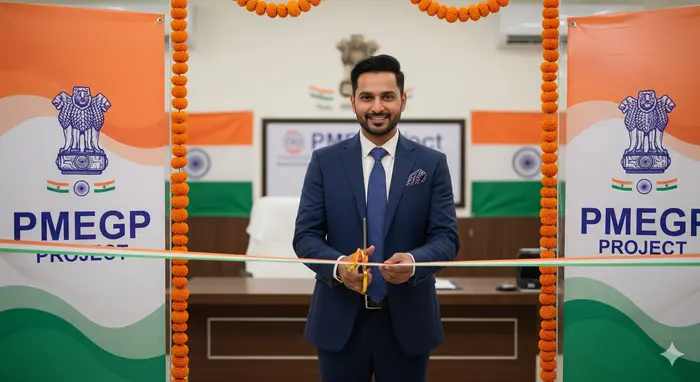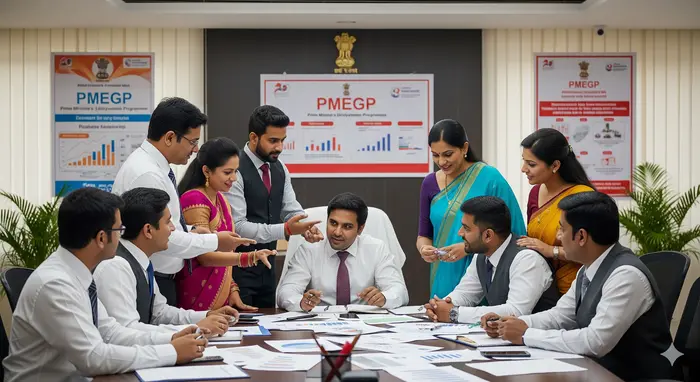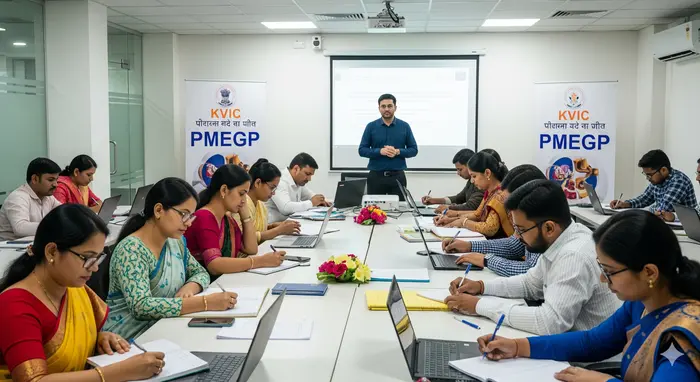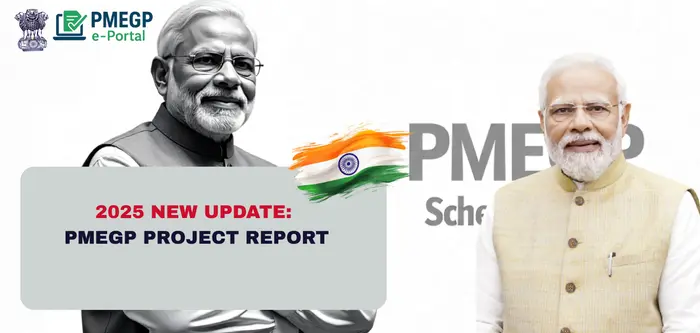Discover the latest PMEGP Project List 2025, featuring 100+ government-approved business ideas. Explore MSME-supported projects, unlock subsidies, and start your entrepreneurial journey with confidence today.

PMEGP Project – A Complete Guide to Government-Approved Business Opportunities in 2025

The PMEGP Project is a government-backed initiative under the Ministry of Micro, Small & Medium Enterprises (MSME) designed to promote entrepreneurship across India. With a focus on self-employment, the scheme provides financial assistance to individuals and groups looking to start new ventures in manufacturing, services, and trading sectors. By offering subsidies and simplified loan procedures, the PMEGP Project encourages the growth of micro and small businesses, creating sustainable livelihoods and boosting the nation’s economy.
Overview of the PMEGP Project
The Prime Minister’s Employment Generation Programme (PMEGP) was introduced to replace earlier schemes like the Prime Minister’s Rozgar Yojana (PMRY) and the Rural Employment Generation Programme (REGP). The main objective of the PMEGP Project is to provide financial support to entrepreneurs who wish to set up new ventures in both rural and urban areas. The scheme targets self-employment for youth, women, and socially disadvantaged groups, ensuring inclusivity and equal opportunity.
| Feature | Details |
|---|---|
| Scheme Name | Prime Minister’s Employment Generation Programme (PMEGP) |
| Implementing Agency | Ministry of Micro, Small & Medium Enterprises (MSME) |
| Beneficiaries | Individuals, groups, NGOs, institutions |
| Loan Assistance | Up to 25 lakh for manufacturing, 10 lakh for service projects |
| Subsidy | 15–35% depending on location and category |
| Coverage | All states and UTs in India |
The PMEGP Project is implemented through the Khadi and Village Industries Commission (KVIC) at the national level, and through state KVIC offices, state directorates, and banks at the regional level. Entrepreneurs can apply for financial assistance online or offline, and projects are selected based on viability, technical feasibility, and potential for employment generation.
Eligibility Criteria for the PMEGP Project

To benefit from the PMEGP Project, applicants must meet certain eligibility criteria. These criteria ensure that financial assistance reaches the right people who are genuinely interested in setting up viable businesses.
- Individuals: Age must be 18 years or older. Those with prior experience in business or training in related trades are preferred.
- Groups/Institutions: Self-help groups (SHGs), NGOs, and co-operative societies can apply with a minimum of 5 members.
- Existing Entrepreneurs: Individuals who have already started a business may not be eligible for assistance under PMEGP.
- Sector: Both manufacturing and service sectors are covered. The maximum loan limit differs based on the type of project.
This structured eligibility ensures that the PMEGP Project supports genuine entrepreneurial efforts while promoting employment generation in both rural and urban areas.
Financial Assistance Under PMEGP
The PMEGP Project provides a combination of subsidy and bank loan, making it easier for entrepreneurs to start businesses without heavy personal investment. The subsidy is a percentage of the project cost and varies depending on the location and category of the applicant.
| Applicant Category | Rural Areas Subsidy | Urban Areas Subsidy |
|---|---|---|
| General | 25% | 15% |
| SC/ST/OBC/Women/Minorities/Ex-servicemen | 35% | 25% |
The maximum project cost supported under the PMEGP Project is Rs. 25 lakh for manufacturing units and Rs. 10 lakh for service units. Applicants can avail of the subsidy directly from banks, which disburse the remaining amount as a term loan. The repayment period is usually 5 to 7 years, with a moratorium period of up to 1 year, depending on the bank’s policies.
Types of Projects Covered
The PMEGP Project covers a wide range of sectors to encourage entrepreneurship across diverse industries. Some key sectors include:
- Manufacturing: Textile, handicrafts, food processing, electronics, metal fabrication, and chemical industries.
- Service Projects: IT services, tourism, transportation, healthcare services, repair and maintenance units, and beauty or wellness centers.
- Trading and Retail: Grocery stores, stationery shops, departmental stores, and other small-scale retail ventures.
By supporting multiple sectors, the PMEGP Project ensures inclusivity and offers opportunities to a wide range of entrepreneurs with different skills and interests.
How to Apply for the PMEGP Project
The PMEGP Project has simplified its application process to encourage more entrepreneurs to participate. Applicants can apply through online portals or by visiting the nearest KVIC office or designated bank.
Online Application Process
- Visit the official PMEGP e-Portal.
- Register with basic personal and business details.
- Fill out the project proposal form, specifying the sector, estimated costs, and expected employment.
- Upload supporting documents such as identity proof, address proof, educational certificates, and experience/training certificates.
- Submit the application for bank scrutiny.
Once submitted, the application undergoes technical and financial appraisal. If approved, the bank sanctions the loan, and the subsidy amount is released directly into the entrepreneur’s account.
Offline Application Process
Applicants who prefer offline submission can visit the nearest KVIC office or designated bank branch. Here, they can:
- Collect the project application form.
- Submit a handwritten project report along with supporting documents.
- Attend interviews or discussions if required.
The bank then processes the loan application, ensures compliance, and releases the funds upon approval.
Benefits of the PMEGP Project
The PMEGP Project is more than just a financial scheme; it offers a wide array of benefits to budding entrepreneurs:
- Financial Support: Subsidy reduces the upfront investment burden.
- Encourages Self-Employment: Provides an opportunity to start a business without heavy dependence on personal savings.
- Job Creation: Each PMEGP project generates employment for at least 2–5 people, depending on the sector.
- Inclusive Opportunities: Special focus on women, minorities, SC/ST, and other disadvantaged groups.
- Government Support: Provides mentorship, training, and advisory services through KVIC.
By facilitating entrepreneurship, the PMEGP Project contributes to economic growth while empowering individuals to become self-reliant.
PMEGP Project Success Stories
Many successful entrepreneurs across India have benefited from the PMEGP Project. From small textile units in rural Maharashtra to IT service centers in urban Bengaluru, these projects have transformed lives by providing steady income and business growth opportunities.
For example, a young entrepreneur in Uttar Pradesh used the PMEGP Project to start a food processing unit. With an initial subsidy of Rs. 3 lakh, he expanded his business within two years, employing more than ten local workers. Similarly, women-led tailoring and handicraft units in Tamil Nadu have leveraged the PMEGP Project to reach national and international markets.
These success stories highlight how the scheme is not just about loans but about creating sustainable livelihoods and promoting entrepreneurship culture across India.
Challenges and Tips for Applicants
While the PMEGP Project offers substantial benefits, applicants should be aware of certain challenges:
- Project Viability: Projects must be technically and financially feasible. Poorly planned projects may get rejected.
- Documentation: Incomplete or incorrect documentation can delay approval.
- Bank Processing Time: Loan sanctions may take several weeks, requiring patience.
- Market Research: Entrepreneurs must conduct market research to ensure demand for their product or service.
Tips:
- Attend PMEGP training programs offered by KVIC.
- Prepare a detailed project report before applying.
- Choose a project aligned with your skills and local market demand.
- Maintain transparent accounts and follow bank guidelines strictly.
PMEGP Project – Future Opportunities
With the Indian government emphasizing self-reliance and startup culture, the PMEGP Project is expected to expand further. Future plans include:
- Increased digital integration for faster approvals.
- Special focus on technology-driven and green projects.
- Enhanced support for women and rural entrepreneurs.
- Training and mentorship programs to improve project success rates.
Entrepreneurs who leverage the PMEGP Project now are well-positioned to benefit from a supportive ecosystem, financial assistance, and guidance for long-term business growth.
Conclusion
The PMEGP Project is a cornerstone of India’s entrepreneurship ecosystem, offering financial aid, subsidies, and guidance to aspiring business owners. By providing opportunities across manufacturing, service, and trading sectors, the scheme empowers individuals to achieve self-employment and contribute to the nation’s economy. Whether you are a young entrepreneur, a woman seeking independence, or a group aiming to launch a small business, the PMEGP Project offers the tools and support needed for a successful venture.
By carefully planning your project, understanding eligibility criteria, and leveraging the financial assistance offered, you can transform your idea into a profitable and sustainable business. The PMEGP Project continues to open doors for thousands of aspiring entrepreneurs every year, making it a vital pathway toward economic growth and self-reliance in India.
Read More: PMEGP EDP Training – Mandatory Skill Development Program for Loan Applicants ( 2025 )
Read More: PMEGP Home | PMEGP E-Portal 2025 – Quick Loan Application, Reliable Status Tracking & Project Info
Read More: Download Free PMEGP Scheme in PDf 2025
Read More: Free PMEGP Subsidy Eligibility 2025 – Secure Guaranteed Aid for Rural & Urban Entrepreneurs
Verified Portals for Public Interest
- 1stHEADLINE.COM — Stay updated with top news, entertainment, and current affairs. Trusted journalism meets verified updates.
- MYTAMPANOW.COM — Local Tampa news and community stories. Your city, your headlines.
- EDPTRAININGS.IN — EDP and PMEGP training resources designed for entrepreneurs across India.
- 99FABRICS.IN — Premium supplier of lining, canvas, and jute materials trusted by garment professionals.
- WBINDIA.IN — Easy access to simplified updates on Central and State Government welfare schemes.
- KHADYASATHI.IN — Official West Bengal food and ration services portal for citizens.
- RATIONCARDINDIA.COM — Nationwide guide to ration card details, status updates, and EPDS services.
- EPDS2.RATIONCARDINDIA.COM — Reliable access point for public distribution and ration services.
- BANGLASTUDENTCREDITCARD.IN — State-backed education loan details for students in West Bengal.
- PURIHOTELBOOKING.CO.IN — Discover and book verified hotels and accommodations in Puri, Odisha.
- BANGLASHASYABIMA.NET.IN — Accurate details on crop insurance and benefits for West Bengal farmers.
- FIRSTHOMEOWNERGRANTS.COM — Helping first-time buyers in Australia with home grants and property insights.
- REGOCHECKER.COM — Quick car registration and history checks for Australian vehicle owners.
- USAFEDERALGRANTS.COM — Federal grant programs and financial aid opportunities in the United States.
- CARDYATRA.COM — India’s go-to platform for comparing credit cards, offers, and financial products.
- PMEGPEPORTAL.COM — A transparent source for checking your PMEGP loan status and progress.
- BESTUSCARACCIDENTLAWYERS.COM — Find trusted legal professionals specializing in car accident claims across the US.


Pingback: PMEGP Application Status By Name – Instantly Track Your Approval ( 2025 ) | PMEGP E-Portal
Pingback: PMEGP Apply Online In 2025 – Step-by-Step Guide For Easy Application | PMEGP E-Portal